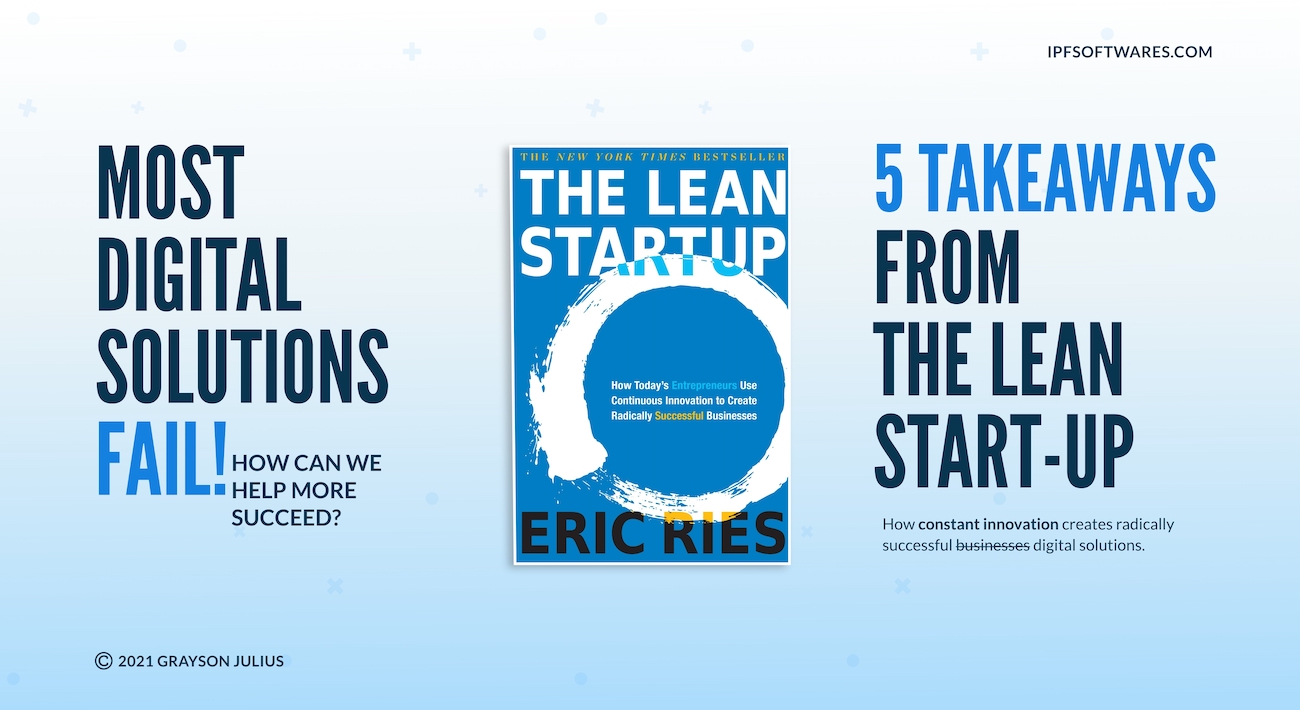In this article, I cover Key lessons for startups, entrepreneurs, innovators, and business leaders; on how to successfully innovate, design, and develop software applications using the lean startup methodology.
Most digital solutions and innovations fail; out of 10 solutions only 1 will have a chance to succeed.
Now you’re probably reading this article because you don't want to become yet another statistic in the pile of failed product owners.
Being a tech entrepreneur myself with my team at iPF Softwares, I know this feeling all too well.
We’ve made mistakes and failed a number of times launching some of our in-house software products, and most importantly learned some very valuable lessons.
We’ve also been fortunate enough to succeed in other endeavors as well as helping our partners and clients successfully innovate, design, and develop more than 25 software applications and solutions some of which are being used all across Africa in 11 countries with more than 25,000 active users.
One of our clients at iPF Softwares asked me to recommend her the best book to read on “ innovation and digital product development “,
Me: The best books! or the best of the best?
Her: No, I just need to read one so the best, please.
On the top of my mind, I had two options: The Lean Start-Up and Hooked; I was indecisive between the two since I like them both, so I decided to do a short opinion poll on Instagram, Twitter, and Linkedin 60% of voters recommended The Lean Startup.
The results inspired me to go back to my notes, refresh my memory on the book I had read in 2019 and write this article to share my key takeaways with examples on how you can successfully design and develop software solutions using the lean startup methodology.
What is a lean start-up?
The term "lean startup" was coined in the early 2000s and became a methodology in 2010. It was created by Steve Blank and Eric Ries, two Silicon Valley entrepreneurs.
Lean Start-Up is a methodology for establishing businesses and products that attempt to shorten product development cycles;
2011 Eric Ries, published the book titled “ The Lean Start-Up “ within 330+ pages, Eric has shared his experience as a business expert and innovator on How Today's Entrepreneurs Use Continuous Innovation to Create Radically Successful Businesses. — while the majority of examples in the Lean Start-Up are technology-based, the concept may be applied in any industry that requires innovation.
How to successfully develop software applications using the Lean Start-Up Approach?
Lesson 1: Avoid Vanity Metrics
Vanity metrics are numbers that appear impressive on the surface but don't always translate into meaningful business outcomes.
The number of social likes, followers, views on promotional videos, media mentions they’re not actionable performance metrics; unless they directly reflect the revenue you collect your customer’s satisfaction.
We were once victims of this with our failed product “ African Fashion “ back in 2015 despite having colorful metrics i.e 1,000 + Google Play Store downloads, our story got covered by BBC and listed as one of the finalists East Africa’s Mobile Application Context ( Pivot East ); we failed to monetize our application, the product died in 2015 - there are many other factors to the failure of our first product, maybe a story for another day.
As a product owner, you should focus on capturing actionable performance metrics; an actionable Metric is one that links specific and repeatable actions to observed outcomes; below are a few examples of actionable metrics.
- What percentage of free users become paid users
- Number of renewed subscriptions
- Net Promoter Score, how much are they willing to refer your digital product
Lesson 2: Pivot based on Key Metrics
Pivot when you discover the current products or services aren't meeting the market's expectations, pivoting involves completely changing the course of your digital solutions or service.
A pivot's major purpose is to assist a company in increasing revenue or surviving in the market.
Don’t get too attached to your current strategy and the original idea or purpose, of course, this doesn’t mean you have to change quickly when you face some minor obstacles, let the actionable metrics help you decide, most importantly is what do the users really need - Make them happy.
Example of the famous Pivot: YouTube 2005
The unofficial tagline of the video-dating site YouTube, which started on Valentine's Day in 2005, was "Tune In, Hook Up." The idea was never taken seriously.
As a result, when the co-founders learned that users were using the site in ways they hadn't intended, they pivoted.
“Tune In, Hook Up “, Ah sounds so interesting to let go of this tagline :), imagine you were part of the YouTube founding team, would you buy into the idea of pivoting?
For more famous and successful business pivots read this article by The CEO Magazine
Lesson 3: Be quick launching the Minimum Viable Product MVP
A Minimum Viable Product, or MVP, is a development model in which a new product is presented to the market with only the most basic functionality, yet enough to attract consumers' interest.
Only after receiving adequate feedback from the product's early users is the completed product released to the market.
In building a digital solution be it a mobile application or website application, speed is important as you only have limited time to build and test your solutions before you run out of investment capital; I have previously shared about developing the perfect MVP, so I won’t write much about this subject in this article.
 Minimum Viable Product
Minimum Viable ProductLesson 4: Observe & Learn Customer Behaviour
Get out on the field and spend time with your customers. Watch them use your software solution and you’ll be shocked how they use it.
You’ll witness first-hand struggles as they use your application or be surprised at how they creatively navigate through it in ways you had never intended or imagined.
Technology has made it easy to analyze user behavior; Use analytics tools to gain insights about your users. Free tools like Google Analytics will help you gain insights about your product growth and how you can strategically repurpose and optimize your digital solution to serve your customers better; it’s actually simple to learn how to effectively measure and analyze data using google analytics: Enroll and learn this free course by the Google Analytics team.
 Care's Chomoka x iPF Softwares Team | Group Visit
Care's Chomoka x iPF Softwares Team | Group Visit Lesson 5: Stay Lean
Ries once advised companies to use the product discovery stage to quickly identify what isn't working so they can make instant improvements.
The product discovery and ideation process allow an innovator to test their ideas and solutions before investing a lot in the development.
At iPF Softwares, we guide our clients and partners through the process of building a quality application aligned with their business objectives with ideation, prototyping, and UI / UX design which is the first step in our software development process.
As an award-winning software development company in Tanzania, we frequently interact with innovators, business leaders, and startups from a variety of industries.
Our approach has been to first understand and evaluate a project, its scope, and technical requirements to determine whether we are a technical and strategic fit.
With years of experience in technology and innovation, we have almost perfected the art of developing digital solutions; yet flexible enough to adapt and learn quickly on what’s working and what isn’t - our services include Product Discovery, Ideation & Design, Custom Software Development, and Product Scaling & Future Proofing.
Our work has cut across the continent and we’re proud to have impacted more than thousands of people in Africa, from East, South, to West Africa learn more about our work iPF Softwares.





